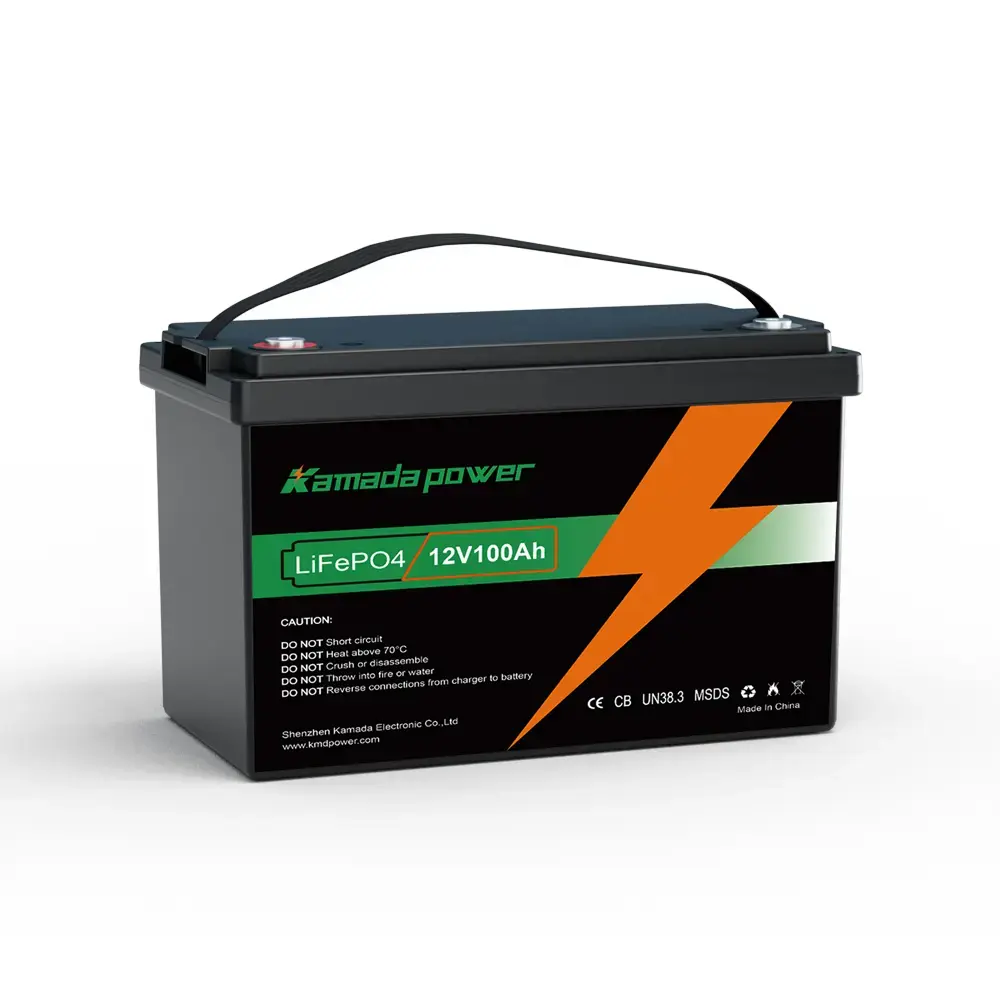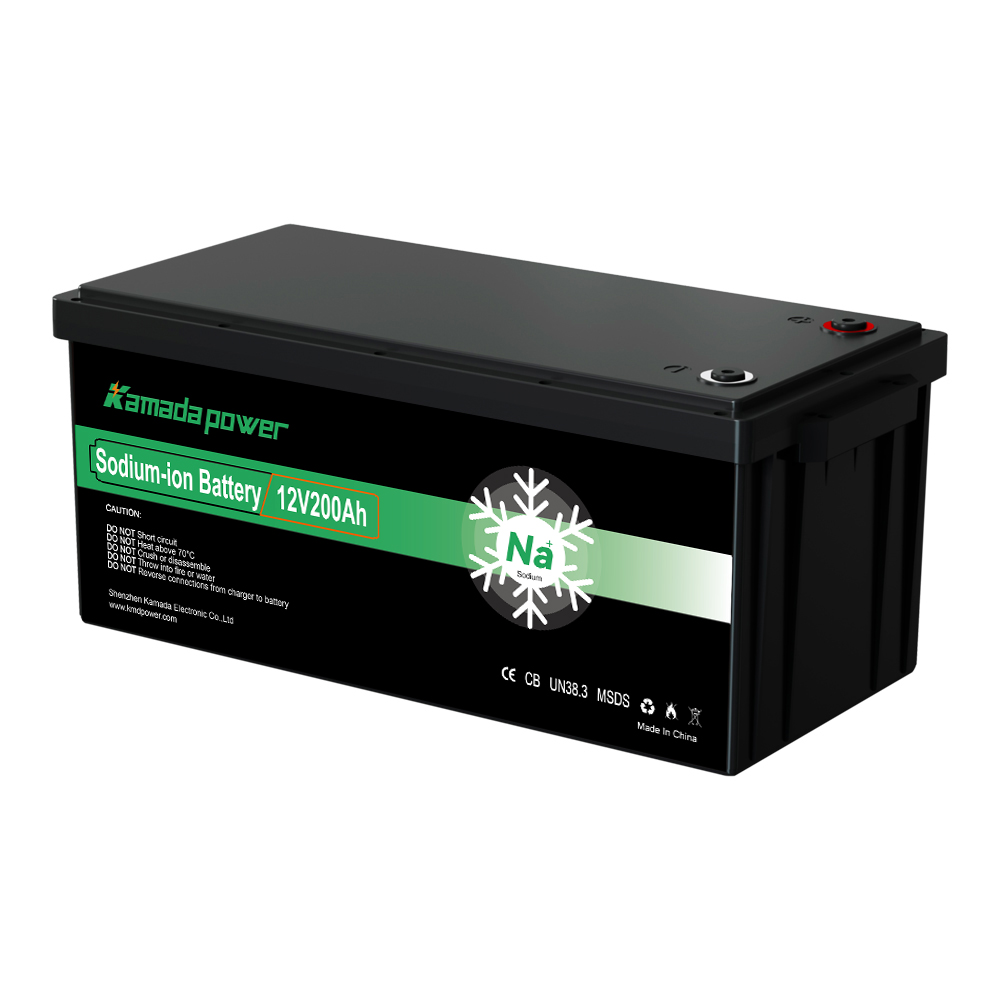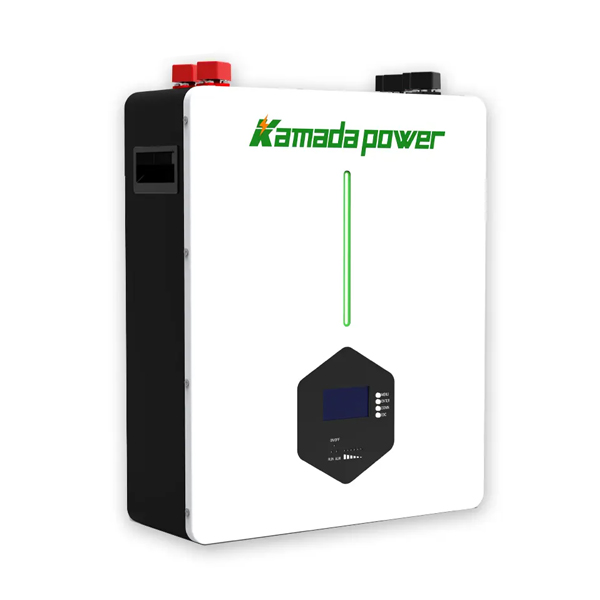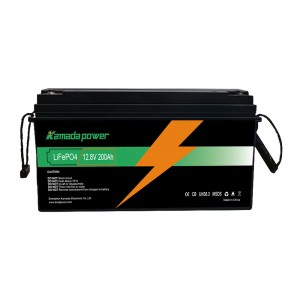Alright folks, let’s talk about one of the questions I hear all the time, especially when the fishing season gets going here in the States: “Seriously, how long will a 100Ah battery run my trolling motor?” You glance at the amp-hour rating, maybe punch numbers into an online calculator, but anybody who’s spent time on the water knows it’s rarely that cut and dried.
Look, I’ve been neck-deep in the battery world for over 15 years, focusing heavily on lithium setups for boats, RVs, you name it. I’ve seen firsthand how those simple specs can lead you astray. Why? Because they don’t tell the whole story. So, let’s cut through the marketing fluff for a second. We’re gonna break down what actually dictates your 100Ah battery trolling motor runtime and how you can get a way better handle on what your setup can realistically do.

kamada power 12v 100ah trolling motor battery
The Basic Math: Good Start, Bad Finish
You’ve probably stumbled across the basic formula:
Runtime (Hours) = Battery Capacity (Ah) / Motor's Average Amp Draw (Amps)
So, yeah, for a 100Ah battery pulling 10 amps, the math spits out 10 hours (100 / 10 = 10). Easy peasy.
Except… hold your horses. While that gives you a theoretical number, it’s usually way off in the real world. It completely ignores a slew of critical things that chew up your power. Think of it like the EPA mileage estimate on a new truck versus what you actually get hauling a trailer uphill. Let’s dig into what that simple math misses.
What’s Your Motor Actually Drawing? It’s All Over the Place!
That “Motor Amp Draw” part of the equation? It’s not some fixed number. It jumps around constantly depending on how you’re using the motor.
Thrust Settings and Speed – The Power Hog
This is the biggie. Putzing along on the lowest setting? Your motor might just be sipping a few amps. But need to crank it too high to fight a nasty headwind or hold a position in current? Bam! That amp draw can easily shoot up 5, 10, or maybe even 15 times higher. And it’s not a straight line – pushing your boat faster takes exponentially more juice. Trying to double your speed demands way more than double the power.
Motor Efficiency and Just Plain Age
No machine is perfectly efficient; some power always turns into heat. On top of that, an older trolling motor, maybe one that’s seen better days maintenance-wise, might need a bit more current to give you the same push as a shiny new one. Usually not a night-and-day difference, but these little things add up.
Trolling Motor Amp Draw Chart (Ballpark Figures)
To give you a rough visual, here are some estimated amp draws for common 12-volt trolling motors. Now, let me be crystal clear: These are just general examples! Your specific motor model, the actual voltage your battery is putting out (it changes!), and the conditions you’re in will change these numbers. Seriously, dig out your motor’s manual or hit the manufacturer’s website for the real specs.
| Motor Thrust (Approx.) | Speed Setting | Estimated Amp Draw (@ 12V) |
|---|---|---|
| 30 lb Thrust | Low/Slow (Setting 1-2) | ~ 5 – 10 Amps |
| 30 lb Thrust | Medium (Setting 3) | ~ 15 – 20 Amps |
| 30 lb Thrust | High/Max (Setting 5) | ~ 25 – 35 Amps |
| 55 lb Thrust | Low/Slow (Setting 1-2) | ~ 6 – 12 Amps |
| 55 lb Thrust | Medium (Setting 3) | ~ 20 – 30 Amps |
| 55 lb Thrust | High/Max (Setting 5) | ~ 40 – 55 Amps |
(Quick note: If you’re running a 24V or 36V system, your amps will be lower for the same thrust, but that’s a whole different battery setup).
What’s the big takeaway here? Check out how drastically the amps jump from low to high speed. Anytime you can run slower, you’re saving serious battery life. It’s that simple.
The Real Kicker: Battery Type Changes Everything (Lead-Acid vs. LiFePO4)
Okay, this is where that “100Ah” label on the battery case can really fool you. A 100Ah battery isn’t just a 100Ah battery when it comes to actually powering your gear. The chemistry inside makes a massive difference. We’re mostly comparing old-school lead acid (that includes Flooded, AGM, and Gel types) against the much newer Lithium Iron Phosphate (LiFePO4) – the stuff that’s taken the marine world by storm lately.
Usable Capacity (Depth of Discharge – DoD): The Biggest Factor You Can’t Ignore
This is probably the most important piece of the puzzle after how hard your motor is working.
- Lead-Acid (AGM, Gel, Flooded): See that 100Ah rating? Forget about using all of it. To make a lead-acid battery last, you really shouldn’t drain it past 50%. Go deeper regularly, and you’re killing it fast. So, that 100Ah lead-acid battery? It realistically gives you only about 50Ah of power you can use day in and day out.
- Lithium Iron Phosphate (LiFePO4): Totally different story here. You can hammer on these things, using 90%, 95%, or even 100% of their rated capacity routinely without wrecking their lifespan (which is already way longer than lead acid anyway). So, your 12v 100Ah LiFePO4 battery delivers a solid 90-100Ah of usable juice.
Let that sink in. Same “100Ah” sticker, but the LiFePO4 gives you potentially almost double the runtime on the water. This single difference explains why so many fishermen rave about how much longer they can fish after switching to lithium.
Holding Voltage Under Pressure
Do you ever feel your trolling motor getting kinda weak and sluggish as your old lead-acid battery gets drained? That’s “voltage sag.” When you pull amps from lead acid, especially a lot of amps, the voltage drops noticeably. Less voltage = less power getting to your motor.
LiFePO4 plays a different game. It holds its voltage much more steadily through almost the entire discharge. Your motor gets strong, consistent power right until the battery is nearly empty. It feels more powerful for longer because it is. That feeling of sustained performance is something lead-acid just can’t deliver.
Yeah, Weight Matters Too
It’s not just about electrons. Your typical 100Ah lead-acid brick can tip the scales at 60, 70 pounds, and sometimes more. A 100Ah LiFePO4? You’re often looking at under 30 pounds. Shaving that much weight off your boat, especially smaller ones, means your trolling motor doesn’t have to work quite as hard. It’s another small piece contributing to better overall efficiency.
Understanding Real-World Trolling Motor Drains
Okay, even with the right battery math, other things out on the water are trying to cut your day short:
Why is My Trolling Motor Battery Draining So Fast?
Fighting a stiff breeze, battling strong currents, or just plowing through choppy water makes your motor work way harder and suck down amps faster. The difference between a glassy calm day and a windy one can slash your runtime in half. Trust me, I’ve seen guys completely drain batteries just fighting a 15 mph wind trying to get back to the boat ramp.
Your Boat Itself
Heavier boat? Needs more thrust, and burns more amps. Is a hull shaped more like a barge than a bullet? More drag, more amps. Loaded down with gear, coolers, and buddies? Yep, more weight, more amps.
How Healthy is Your Electrical System?
Good maintenance isn’t just about looking pretty; it directly impacts runtime.
- Wiring Woes: Using wires that are too skinny (undersized gauge) for the amps and the distance they run is like trying to drink a thick milkshake through a tiny straw. It creates resistance, wastes precious battery power as heat, and starves your motor.
- Crappy Connections: Those fuzzy green or white crusties on your battery terminals? That corrosion, along with loose connections, acts like a roadblock for electricity. It bumps up resistance and means less power makes it to your motor. Keep ’em clean and crank ’em down tight! I swear, I’ve seen more batteries underperform due to bad connections than almost anything else.
- Battery Age: Nothing lasts forever. All batteries lose capacity as they get older and rack up cycles. Lead-acid types typically fade much faster, especially if they haven’t been treated perfectly (and who treats them perfectly?).
How Do I Actually Figure Out My Runtime?
Right, let’s ditch the idea of one magic number. Getting a realistic estimate means thinking like this:
- Know Your Battery: Lead-Acid or LiFePO4? Figure out its real usable amp-hours (rule of thumb: ~50Ah for 100Ah Lead-Acid, ~95Ah for 100Ah LiFePO4). That’s your starting fuel tank size.
- Guess Your Average Burn Rate: Be honest. How do you fish? Mostly slow-trolling or holding spots (lower average amps)? Or lots of running and gunning at higher speeds (higher average amps)? Use that chart earlier as a very rough starting point, then blend it with your habits. Maybe you figure, “Eh, I probably average 15-20 amps most days.”
- Add a “Pain Factor” for Conditions: Do you usually deal with wind or current? Pad your average amp draw estimate. If you think you average 15A, maybe use 20A or even 25A in your calculation on those tougher days just to be safe.
- Factor in Battery Age/Health: Got a brand new battery? Great. Is it a few years old and has seen some hard use? Shave a little off your runtime expectation.
Let’s run a quick example: You’ve got a 12v 100Ah LiFePO4 battery (so ~95 usable Ah). You fish mixed speeds, figure maybe 15A average draw, but it gets breezy, so you bump your planning number to 18A. Rough Realistic Runtime: 95 Ah / 18 A = Around 5.3 hours.
Now, same boat, same fishing style, but with a 100Ah Lead-Acid battery (~50 usable Ah): Rough Realistic Runtime: 50 Ah / 18 A = Around 2.8 hours.
Big difference, right? Same boat, same motor use, same “100Ah” sticker – potentially hours more fishing time with the lithium.
Expert Tip: Honestly, the absolute best way to know your runtime is to track it. Charge your battery full. Go fish like you normally do. Make a rough mental note (or actual note!) of how long you ran the motor and generally how hard. Check your remaining charge when you get back (a simple voltmeter or a fancy battery monitor helps). Do this a couple of times, and you’ll quickly get a gut feeling for what your setup delivers in your conditions.
Pro Tips: Squeeze More Juice from Your 100Ah Setup
Want to stay out longer without buying a bigger battery? Try these:
Ease Off the Throttle
We saw the amp draw chart – high speeds kill batteries fast. Use the lowest setting you can get away with. Resist the urge to run wide-open unless you have to. Backing off even a little bit makes a huge difference.
Keep Your Gear Shipshape
- Sparkling Connections: Clean those battery terminals! Get rid of any corrosion (a wire brush and some terminal protector spray work wonders). Make sure the nuts are tight. Check connections at the motor and any plugs too.
- Fat Wires: Use the right size wire for the length of the run and the amps your motor pulls. Check your motor manual’s recommendation. If you’re running wires a long distance, go thicker! Good resources like the American Boat & Yacht Council (ABYC) have charts for this if you’re wiring it yourself. (External Link Suggestion: Link to ABYC website or a relevant section if accessible, or a reputable marine electrical resource explaining wire gauge)
- Charge Smart: Use a quality charger designed for your battery type. LiFePO4 batteries need a specific lithium charging profile – don’t use your old lead-acid charger unless it explicitly has a LiFePO4 mode. And try not to leave lead-acid batteries sitting around half-dead; it shortens their life.
Choose Your Battery Wisely
If getting the max runtime and consistent power matters most, that 100Ah LiFePO4 is going to give you way more bang for your buck out on the water than a 100Ah lead acid. Yeah, they cost more upfront, no doubt. But when you factor in getting maybe 5-10 times the lifespan and all that extra usable power trip after trip… well, for a lot of serious boaters, the long-term value makes perfect sense.
Conclusion
Let’s circle back to the big question: Is a 100Ah battery enough for your trolling motor?
You guessed it: It really depends.
- If it’s a 100Ah LiFePO4: For most folks running typical freshwater trolling motors (up to maybe 55-70 lbs thrust) and fishing for a normal day without constant high-speed runs or battling heavy current, yeah, it’s often going to be plenty. You get a lot of usable power out of that package.
- If it’s a 100Ah Lead-Acid: With only half the usable capacity (~50Ah), it might be okay for short trips, really light use, maybe on a small pond boat or kayak. But for longer fishing days, bigger boats, or tougher conditions, you’ll likely be watching your battery meter nervously way before you want to head in.
It boils down to knowing your motor, how you fish, the waters you’re on, and the actual type of 100Ah battery strapped in your boat.
Making the Smart Choice
Figuring out how long your 100Ah battery will last isn’t about finding some secret number online. It’s about understanding what’s going on: how many amps your motor pulls, the huge difference usable capacity makes (especially LiFePO4 vs. Lead-Acid), and all those little things like wind and wiring that add up. Battery tech, especially lithium, keeps getting better, so it pays to stay informed.
Think through these points for your setup, and you’ll be way better equipped to estimate your runtime and pick the battery that keeps you out on the water doing what you love.






